-
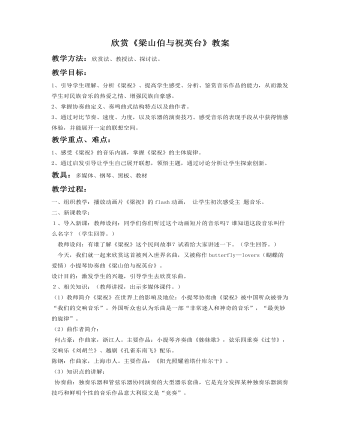
欣赏《梁山伯与祝英台》教案
教学过程:一、组织教学:播放动画片《梁祝》的flash动画, 让学生初次感受主 题音乐。二、新课教学:1、导入新课:教师设问:同学们你们听过这个动画短片的音乐吗?谁知道这段音乐叫什么名字?(学生回答。) 教师设问:有谁了解《梁祝》这个民间故事?试着给大家讲述一下。(学生回答。) 今天,我们就一起来欣赏这首被列入世界名曲,又被称作butterfly—lovers(蝴蝶的爱情)小提琴协奏曲《梁山伯与祝英台》。设计目的:激发学生的兴趣,引导学生去欣赏乐曲。2、相关知识:(教师讲授,出示多媒体课件。)(1)教师简介《梁祝》在世界上的影响及地位:小提琴协奏曲《梁祝》被中国听众被誉为“我们的交响音乐”。外国听众也认为乐曲是一部“非常迷人和神奇的音乐”,“最美妙的旋律”。(2)曲作者简介: 何占豪:作曲家,浙江人。主要作品:小提琴齐奏曲《姊妹歌》,弦乐四重奏《过节》,交响乐《刘胡兰》、越剧《孔雀东南飞》配乐。陈钢:作曲家,上海市人。主要作品:《阳光照耀着塔什库尔干》。(3)知识点的讲解: 协奏曲:独奏乐器和管弦乐器协同演奏的大型器乐套曲,它是充分发挥某种独奏乐器演奏技巧和鲜明个性的音乐作品意大利原文是“竞奏”。3、下面,欣赏《梁祝》的主要部分音乐。
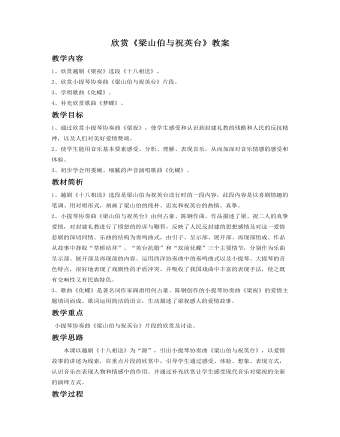
欣赏《梁山伯与祝英台》教案
教学过程第一环节:恋蝶——欣赏越剧《十八相送》感受越剧韵味,了解越剧。 1、提问导入特点,并为欣赏下一作品做好铺垫。(1)越剧是浙江地方戏剧剧种之一,你能说出一些著名的越剧代表作品吗?(2)导出越剧《梁祝》并请学生说说梁祝故事。(3)教师小结。(4)欣赏越剧《十八相送》。(5)简单介绍越剧特点(唱腔、语言)。第二环节:颂碟——欣赏小提琴协奏曲《梁祝》片断。1、导入:介绍作品地相关知识。(1)教师:这个千古传颂的爱情故事可以用越剧的形式来表现。那么,我们是否可以用其他形式来表现呢?我们中国就有两位作曲家何占豪和陈刚,他们为了探索交响音乐的民族化,选择了这一家喻户晓的民间传说为题材,吸取越剧中的曲调为素材,运用西洋手法,成功地创作了一部小提琴协奏曲《梁祝》。(2)介绍乐器小提琴、大提琴(出示图片)。 2、欣赏“爱情主题”(1)请学生聆听爱情主题音乐根据提问,让学生思考:①这段主旋律由哪样乐器演奏? ②这段主旋律有什么特点?自主参与讨论分析作品。(2)学生思考并回答。(3)教师总结: 旋律优美动听、委婉曲折,带有越剧韵味。节奏舒缓,情绪明朗。表现出爱情的美好。3、介绍协奏曲 协奏曲是指一种由独奏乐器与管弦乐队协同演奏的大型器乐作品。在音乐 进行中,独奏乐器与乐队常常轮流出现,独奏时乐队处于伴奏地位。全奏时,独奏乐器休止,完全由乐队演奏。
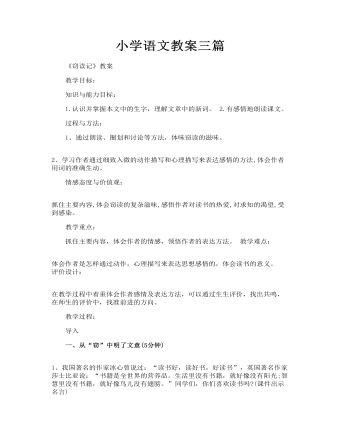
小学语文教案三篇
1、通过朗读、圈划和讨论等方法,体味窃读的滋味。 2、学习作者通过细致入微的动作描写和心理描写来表达感情的方法,体会作者用词的准确生动。 情感态度与价值观: 抓住主要内容,体会窃读的复杂滋味,感悟作者对读书的热爱,对求知的渴望,受到感染。 教学重点: 抓住主要内容,体会作者的情感,领悟作者的表达方法。 教学难点: 体会作者是怎样通过动作,心理描写来表达思想感情的,体会读书的意义。 评价设计: 在教学过程中着重体会作者感情及表达方法,可以通过生生评价,找出共鸣,在师生的评价中,找准前进的方向。
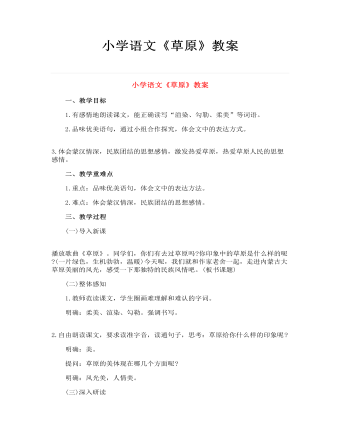
小学语文《草原》教案
二、教学重难点 1.重点:品味优美语句,体会文中的表达方法。 2.难点:体会蒙汉情深,民族团结的思想感情。 三、教学过程 (一)导入新课 播放歌曲《草原》。同学们,你们有去过草原吗?你印象中的草原是什么样的呢?(一片绿色,生机勃勃,温暖)今天呢,我们就和作家老舍一起,走进内蒙古大草原美丽的风光,感受一下那独特的民族风情吧。(板书课题)
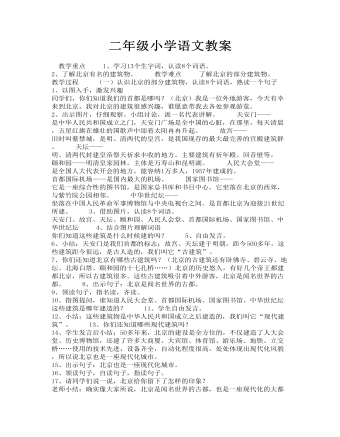
二年级小学语文教案
故宫——旧时叫紫禁城,是明、清两代的皇宫,是我国现存的最大最完善的宫殿建筑群。 天坛——明、清两代封建皇帝祭天祈求丰收的地方。主要建筑有祈年殿、回音壁等。 颐和园——明清皇家园林。主体是万寿山和昆明湖。 人民大会堂——是全国人大代表开会的地方,能容纳1万多人,1957年建成的。
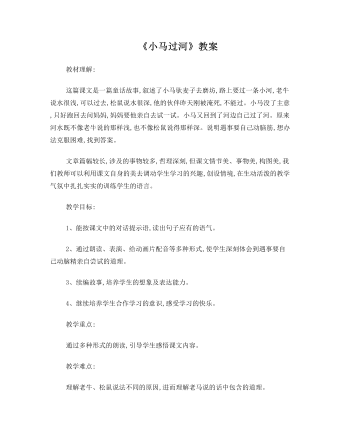
二年级语文小马过河教案
这篇课文是一篇童话故事,叙述了小马驮麦子去磨坊,路上要过一条小河,老牛说水很浅,可以过去,松鼠说水很深,他的伙伴昨天刚被淹死,不能过。小马没了主意,只好跑回去问妈妈,妈妈要他亲自去试一试。小马又回到了河边自己过了河。原来河水既不像老牛说的那样浅,也不像松鼠说得那样深。说明遇事要自己动脑筋,想办法克服困难,找到答案。文章篇幅较长,涉及的事物较多,哲理深刻,但课文情节美、事物美,构图美,我们教师可以利用课文自身的美去调动学生学习的兴趣,创设情境,在生动活泼的教学气氛中扎扎实实的训练学生的语言。
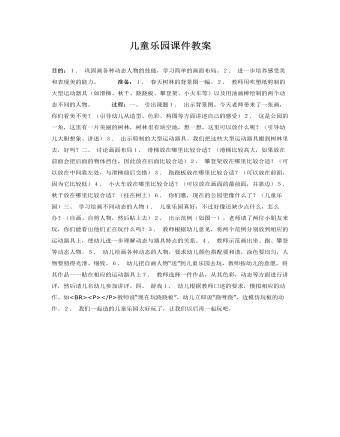
儿童乐园课件教案
准备:1.春天树林的背景图一幅。2.教师用吹塑纸剪制的大型运动器具(如滑梯、秋千、跷跷板、攀登架、小火车等)以及用油画棒绘制的两个动态不同的人物。 过程:一、引出课题1.出示背景图。今天老师带来了一张画,你们看美不美?(引导幼儿从造型、色彩、构图等方面讲述自己的感受)2.这是公园的一角,这里有一片美丽的树林,树林里有块空地,想一想,这里可以放什么呢?(引导幼儿大胆想象、讲述)3.出示剪制的大型运动器具。我们把这些大型运动器具搬到树林里去,好吗?二、讨论画面布局1.滑梯放在哪里比较合适?(滑梯比较高大,如果放在前面会把后面的物体挡住,因此放在后面比较合适)2.攀登架放在哪里比较合适?(可以放在中间靠左处,与滑梯前后交错)3.跷跷板放在哪里比较合适?(可以放在前面,因为它比较低)4.小火车放在哪里比较合适?(可以放在画面的最前面,并靠边)

人教版新目标初中英语七年级上册How much are these pants教案
个性练习设计 阅读广告:在日常生活中,人们去买东西之前,一般要阅读广告,从广告中获取该商品的一些有用信息,包括价格、性能等。所以给学生提供有些商品的广告或让学生去商店去阅读一些商品的广告,从中获取商品的价格,即可以锻炼学生的阅读能力,又能提高实践能力。 Self Check 教学内容 Self Check(教材P42) 教学目标 知识与能力 复习词汇pant,sock,T-shirt,sweater,shoes,color,black,white,red,green,blue,big,short,long,数字10--31; 学习词汇Zig Zag,clothes,shop,yellow,ask,which;学会谈论服装的价格、颜色、大小和长短;学会填写价格标签。 过程与方法 运用Summarizing和Classifying的学习策略。在复习教学中,运用听写、绘画、互相询问调查与检测等手段,促使学生不断地使用所学内容,从而提高他们灵活运用知识的能力。 情感态度价值观 该部分学习内容主要是复习谈论服装的价格和颜色以及对服装的喜好,能引起学生的共鸣;通过购物的对话练习教学生学会购物时使用的礼貌用语和如何感谢人。

人教版新目标初中英语七年级上册My favorite subject is science教案
本单元主要学习一周中星期一到星期天的表达方式;掌握学科的表达;学习用because和表示品质的形容词表示理由;学习what,why,who引导的特殊疑问句。本单元围绕“谈论自己所喜欢的学科”这一话题,设计了三个任务型活动:任务一是:谈论自己所喜欢的学科,学习what引导的特殊疑问句和学科的表达;任务二是:一分钟演讲,让学生介绍自己喜欢某一学科的理由,学习why等特殊疑问句;任务三是:写信,巩固和延伸所学知识,掌握星期的表达方式。单元知识系统(树)What’s your/his/her favorite subject? My/His/Her favorite subject is English.Why do you like math. Because it’s interesting.Why does he/she like art? Because it’s fun.When do you have math? I have math 0n Monday,Wednesday and Friday.What’s Ken’s favorite subject? Science.单元总体目标通过本单元的学习使学生学会谈论自己喜好的学科或自己喜好的其它事情并给出理由;学会说出一周的七天;学会合理地安排自己的作息时间。

人教版新目标初中英语七年级下册How was your weekend教案2篇
Teaching Goal:1. General aims:Talk about recent past events2. Particular aims:A. Language Focus.Talk about recent past events and think of the past events.B. Language goalsHow was….?It was …What did …do over the weekend?C. Language structures:(1). How was your weekend? I was great. Pay attention to no form.(2). What did you do over the weekend? I played soccer. We went to the beach.D. Useful words and phrases:Words: was, did, went, beach, over, project, test, wasn’t, false, number, geography, spend, week, most, mixture, their, had, little, cook, read, saw, change, everyone, sit, sat, no, anythingPhrases: did one’s homework, played soccer, cleaned my room, went to the beach, played tennis, went to the movies, on Saturday morning, over the weekend, cook … for, what about, do some reading, have a party, talk show, go shoppingE. Grammar language:Present simple past tenseRegular and irregular verbsF. Learning strategies:Tour and holidaysG. Interdiscipinary:H. Emotion and manner:Teaching time: 5 periodsTeaching procedures:Period One教学步骤、时间 教师活动 学生活动 媒体应用Step 1Free talk 3’ Ask some questions like:Who’s on duty today?What’s the weather like? Answer and talk about something.让同学们回答下列问题1. Do you like weekend? (Let some students answer)It takes them three minutes to talk about the question.2. Why do you like weekend? (let the students answer) Most of the students like the weekend此时教师用汉语问:“在周末期间问你干了什么?这句话用英语这么回答?Let the students guess.At last the teacher give them right answer3. What did you do over the weekend?(板书、学习)

人教版新目标初中英语七年级下册Where is the post office教案2篇
Period 2 (3a----Section B 2c)Preview(Pre-task): Key points: What laAdd another information about their pen pals----their language on the cardnguage does she/he speak?She/He speaks....Does she/he have any brothers and sisters? Does she/he speak English?Preview(Pre-task): Add another information about their pen pals----their language on the cardKey points: What language does she/he speak?She/He speaks....Does she/he have any brothers and sisters? Does she/he speak English?Step 1 Revision1.Revisionand dictation of the new words 2.Revise the drills they learned yesterday.(by pairwork and grammar exercise)Step 2 Leading-inT has a conversation with one student. The conversation is following:---Do you have a pen pal?---Yes, I do.---What's your pen pal's name? ---His/Her name is....---Where is your pen pal from? ---He/She is from...---Where does he/she live? ---He/She lives in....---What language does he/she speak?He/She speaks...Write the new words on the Bb. They are following: EnglishChineseJapaneseFrenchStep 3 LearnLearn the new words with the whole class.Finish 3a with the students3b Pairwork T still does an example with one student Then the Ss practise in pairs. The example is following:--Curry Muray is my pen pal. He is from the United States.---What language does he speak?

人教版新目标初中英语七年级下册Where is your pen pal from教案
2.1Match the country with the language.Step II Reading3a? let the students read the letter fast and answer the questions.? Let the students ask more questions about the letter as possible as the can.Step III Writing3b.Step IV. Pairwork2cStep V Listening2a, 2bStep V. HomeworkExercises book(1) P3Exercises book (2) P3Period FourStep I . Dictate the words and sentences in Unit1.Step II. Self-checkStep III. Check the answers for Exercises book in the unit.Step IV. Home workRevise and preparation for unit 2.教学反思:通过本单元的学习,学生基本可以谈论人们的国籍,居住城市及其所说的语言,通过书信方式去介绍自己并寻找笔友。但在涉及到国外的一些城市时,学生对这方面的知识相对欠缺,能介绍的城市并不多,也反应出学生课前预习不充分,这跟学生学习条件也有关,大多数学生无法通过网络获取所需信息。因此,在以后的教学中要多指导学生通过计算机网络获取信息,拓宽知识面。

人教版新目标初中英语八年级上册How was your school trip教案2篇
“Go for it!” is based on “Task-Based Language Teaching”. It adheres to “The authenticity principle”, “The form-function principle”, “The task dependency principle” and “The principle of learning by doing”. These principles all accord with the demands of curriculum focus.In and of Grade Seven (II), “Go for it!”, students have learned “The Simple Past Tense”. And it appears again in of Grade Eight (I). teaches students more about how to talk about events in the past. In addition, it gives affirmative and negative statements in the past tense, such as the sentence patterns “Did you see …?” “Were there …?” “Did you go …?” As the first part of Unit 8, Section A opens with a picture presenting the last school trip in the aquarium and continues with several step-by-step practice activities, which are all good for students to master “The Simple Past Tense”. Doing well in Section A will help students integrate the new target language with that in Section B. Thus, they can describe the events in the past freely and foster their own ability of reflecting and practicing. II. Teaching ObjectivesTeaching objective is the beginning and aim of teaching activities. According to the overall goal of the English elementary course--- improve students' synthetic ability of language application, which should be based on the development of students’ “Language knowledge”, “Language skills”, “Character building”, “Learning strategies” and “Cross-cultural awareness”. The teaching objectives are described as follows(I). Knowledge objectivesi. Master the simple past tense of regular and irregular verbsii. Recite the new words and expressions about the last school trip in the aquarium, including their pronunciation and intonation

人教版新目标初中英语八年级上册I’m going to be a basketball player教案3篇
教学目标1.知识目标:(1)学习What are you going to be when you grow up?/How are you going to do that?句式。(2)学会用英语描述有关职业的表达法。2.能力目标:(1)能够谈论为实现理想所做出的打算和安排。(2)能够谈论未来自己与他人理想的职业及原因。(3)能用英语描述课余时间的活动安排,最终具备表达综合信息的能力。3.情感目标:新学期到来之际,让他们在学习、体育、饮食、特长、读书等方面制定计划,教育学生合理安排自己的课外生活,思考自己的理想职业及适合自己的职业。教学重点、难点本单元的重点为“be going to”表将来,want to be, what,where, when,how引导的特殊疑问句。难点是语言目标的实现。教材分析本单元以I am going to be a basketball player为话题,共设计了三部分的内容:一、Section A该部分有4个模块。第一模块围绕Do you think these jobs are interesting?这一话题展开思维(1a)、听力(1b)、口语(1c)训练;

人教版新目标初中英语八年级上册What’s the best radio station教案2篇
教学重点和难点:运用所掌握的语言描述,比较不同地点的特点。在练习中学习掌握英语比较级和最高级的用法。课前准备分配小组,每组五至六人。通过上网或翻阅报刊杂志等方法,确定旅游线路,做出基本的旅游计划。教学设计:本节课流程图 学法指导:1.由于这是一堂新课,在教学中应注意面向全体,发挥学生的主体性,引导学生积极参与,激发学生的求知欲和学习积极性,指导学生积极思维,主动获取知识,养成良好的学习方法。逐步学会独立解决问题。总之要尽可能调动学生的非智力因素促进智力因素的发展。教法选择:1.电化教学法2.课堂讨论法3.任务型教学法采用这些方法的目的是为了充分调动学生的学习积极性,使学生变被动学习为主动学习。通过电脑形象的演示,加强印象,提高兴趣,突破难点,提高教学效率,进而增大教学的容量和信息量。充分体现教师为主导,学生为主体的教学原则。

人教版新目标初中英语八年级下册He said I was hard-working教案2篇
This activity introduces some new vocabulary and provide oral practice using the target language.Task 1 . Ask four students to stand in front of the class, and the teacher asks them the following questions as a reporter.1.What are you going to do when you grow up?2.What are you going to do next week?3.What are going to do after school?The students will give different answers, then ask a good student to report what they said.I am going to e a doctor.What did she say?----------She said she was going to be a doctor.I am going to have a party on Friday night.What did he say?-------He said he was going to have a party on Friday night.I am going to do my homework.What did she say ?------ She said she was going to do her homework.I am going home after school.What did she say?-----She said she was going home after school.Say In this unit we are going to learn to use words like to report what someone said.Task 2. Read the instructions. Then ask a student to read the four questions. And write the words on the Bb. Explain what soap opera is.Task 3. Ask the students to Look at the pictures, point out the TV screens in the picture. Ask one girl to read what Marcia said.What did Marcia say? She said She said she was having a surprise party for Lana on Friday night. Repeat the other pictures in the same way.Activity3. Listen and number the pictures in activity 1a.

人教版新目标初中英语九年级上册Teenagers should be allowed to choose their own clothes教案2篇
Step 1 Greeting Greet the class and check the homeworkStep 2 A duty report The S on duty gives a report on the rules in his home and lead in 3a “Sun Fei’s and Wu Yu’s rules” Step 3 ReadingSs read the conversation and write the two girls’ rules in the chart. Check the answers.Get Ss to read after the tape and then read aloud by themselves. Then, T explains the language points.Step 4 Pairwork 3bRole play. Use the information in chart to practice with the conversation in 3a covered. They can look at the sample conversation in the right box.Step 5 Task 2 “Who’s the best reporter?”Make a survey by asking any 5 students the questions in the chart in activity 4. Then give out a report about it. See who is the best reporter? And the best reporter will get a nice ball-pen.Step 6 Summary and homework:Write out the report in your exercise-books.Period ThreeStep 1 Greeting and a duty reportThe S gives a duty report talking about his experience of being late for school. Lead in the question “Do you ever get to school late? How often do you get to school late? Always, usually, sometimes, or never?Step 2 1a Get Ss to finish writing.Step 3 Pairwork 1b Get Ss to talk about their answers with their partners using the sample conversation in the box on the right.Step 4 Listening practice2a Lead-in: What will happen if you get to school late? What about Peter? Let’s listen to a conversation between Peter and his father. Get Ss to finish 2a (As usual, for the first time, Ss only listen.) Check the answers.

人教版新目标初中英语九年级上册I used to be afraid of the dark教案
内容提示1.本单元主要内容是学会used to结构。Used to +动词原形表示过去经常、以前常常,只用于过去式中,用来表示现在已不存在的习惯或状态。例如:They used to play football together.他们过去常在一起蹋足球。(现在不在一起踢了)2.used to的疑问形式和否定形式为Did you use to…?和I didn’t use to… 也可以用Used you to…?和I used not to…但现在多使用前者。例如:Did you used to swim in the river? 你过去常在河里游泳吗?I didn’t use to play the piano. 我以前并不经常弹钢琴。教学目标一、学习目标(Language Goal) 1.学会陈述自己过去常做的事情。2.学会陈述自己过去的爱好等。3.能够表达自己现在和过去在外表、性格、娱乐等方面的变化。4.能够表达朋友、家人等现在和过去的变化。二、语言结构(Language Structures) 1.I used to be short when I was young. 我年轻时个子很矮。 2. —Did you use to have straight hair? 你过去是直发吗?—Yes, I did. 是的。 3. —Did you use to play the piano? 你过去弹钢琴吗?—No, I didn’t. 不,我不弹。 4.I used to be afraid of dark. 我过去害怕黑暗。 5.I’m terrified of the snakes. 我害怕蛇。

人教版新目标初中英语九年级下册By the time I got outside, the bus had already left教案
Ⅰ. Teaching Aims and Demands1. Knowledge Objects(1) Key Vocabularyoversleep(2) Target LanguageWhat happened?I overslept. And by the time I got up, my brother had already gotten in the shower.2. Ability Objects(1) Teach the students to use the new words.(2) Train the students to narrate past events with the Past Perfect Tense.(3) Train the students' listening and speaking skills with the target language.3. Moral ObjectIt’s a good habit to go to bed early in the evening and get up early in the morning. So you’ll never be in a hurry in the morning.Ⅱ. Teaching Key Points1. Key Vocabularyoversleep2. Target LanguageNarrate past events with the Past Perfect TenseⅢ. Teaching Difficult Points1. Train the students to narrate past events with the Past Perfect Tense.2. Train the students to understand the target language in spoken conversation.Ⅳ. Teaching Methods1. Thinking of examples from the students' real lives.2. Making sentences by looking at the pictures.Ⅴ. Teaching AidA tape recorderⅥ. Teaching ProceduresStep I Revision1. Revise the language points in Unit 8.Ask some questions like this: What volunteer work would you like to do?Help the students to answer, I’d like to…/I love to…/I hope to2. Practice the dialogue in Activity 3c on page 62 again. Get students to role play the similar dialogues with the following.

人教版新目标初中英语九年级上册It must belong to Carla教案
一、Section A该部分有4个模块。第一模块围绕Whose volleyball is this? 这一话题展开思维( 1a)、听力(1b)、口语( 1c)训练;第二模块围绕上一模块中的话题进行听力( 2a-2b)、口语训练( 2c);第三模块继续围绕前两个模块中的“making inferences”展开训练。训练形式为阅读排序( 3a)和两人问答(3b);第四模块仍就上一话题展开讨论。二、Section B该部分有4个模块。第一模块要求根据图画和所提供的单词写出合理的句子;第二模块在听力( 2a-2b)和分角色口语训练( 2c)的基础上,继续进行“推测”训练; 第三模块围绕“Strange events in Bell Tower neighborhood”这一话题展开阅读( 3a)和写作(3b -3c)训练;第四模块以dream为话题展开小组活动。三、Self Check该部分有3个模块。第一模块以填空形式对所学词汇进行训练;第二模块就8个谚语展开阅读和讨论。

